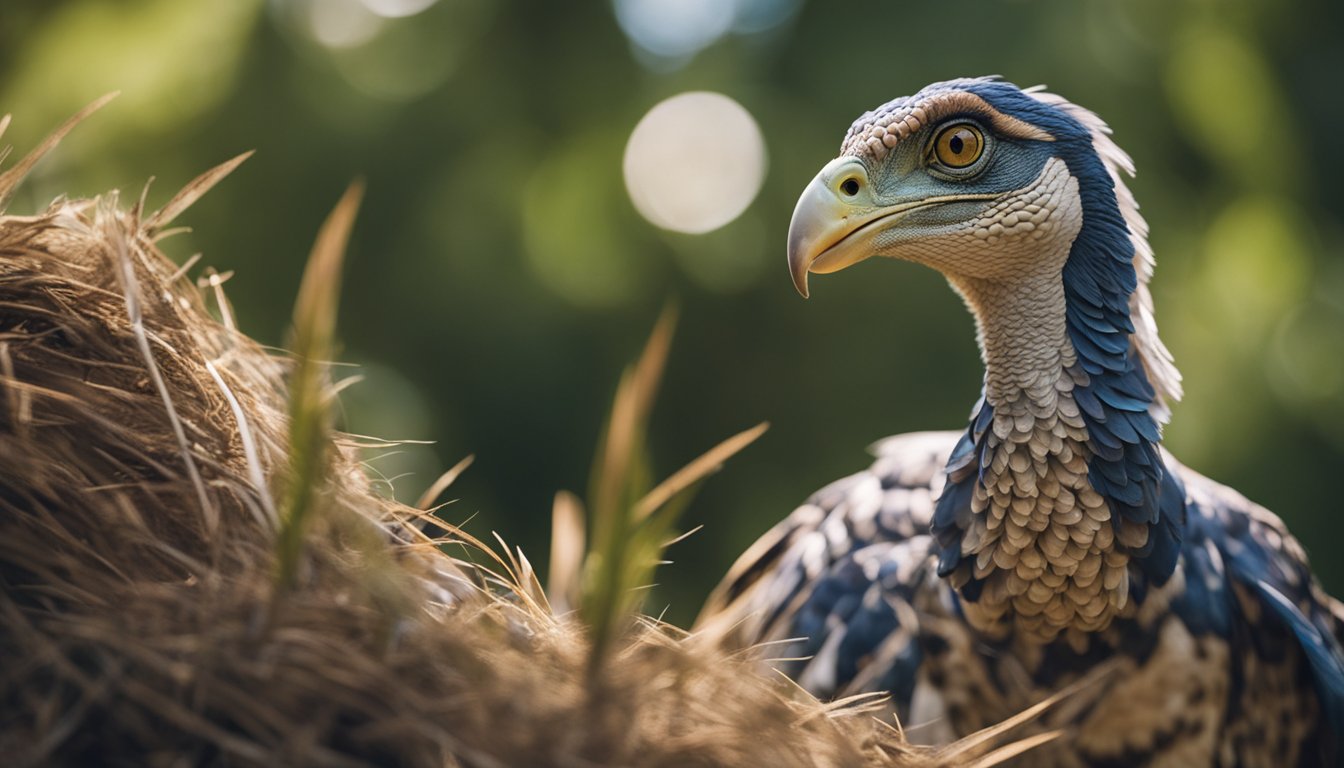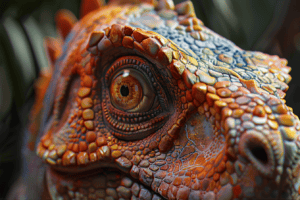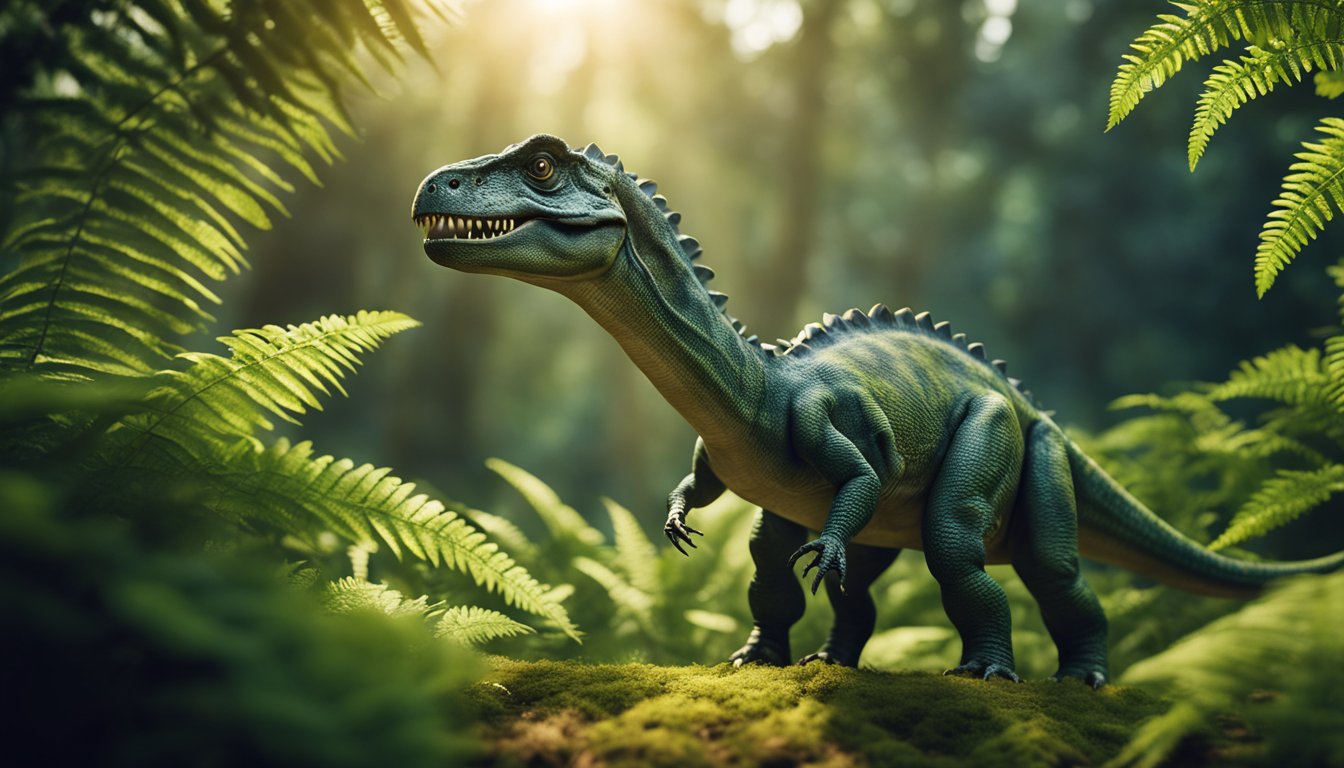Oviraptor, the name itself sounds like a menacing dinosaur, conjuring up images of a fierce predator stealing eggs from unsuspecting mothers.
However, recent research has revealed that this image of Oviraptor as an egg thief is far from the truth.
In fact, Oviraptor was a caring parent that fiercely protected its own eggs.

Initially discovered in Mongolia in 1923 by paleontologist Roy Chapman Andrews, Oviraptor was named “egg thief” because it was found near a nest of eggs.
However, subsequent research has revealed that the eggs were actually Oviraptor eggs, and the dinosaur was likely protecting its own offspring.
This discovery has completely changed our understanding of Oviraptor and its behavior.
Despite being misunderstood for many years, Oviraptor has now become known as a caring parent, fiercely protecting its eggs from predators.
This fascinating dinosaur has captured the imaginations of scientists and dinosaur enthusiasts alike, and continues to teach us about the wonders of the prehistoric world.
Unveiling the Oviraptor
Discovering the First Fossil
The Oviraptor is a genus of oviraptorid dinosaur that roamed the earth during the Late Cretaceous period.
The first fossil of Oviraptor was discovered in Mongolia in 1923 by paleontologist Roy Chapman Andrews [1].
The initial assumption was that this dinosaur stole the eggs of other dinosaurs, hence its name.
However, subsequent research has revealed a different story.
Physical Characteristics and Anatomy
Oviraptor was a theropod dinosaur that measured up to 8 feet in length and weighed up to 100 pounds [2].
The Oviraptorosaur had a toothless beak and a long neck that it used to reach for vegetation.
The Oviraptorosaur also had a crest on its head that was used for display purposes.
The crest was made of thin, bony rods that projected upwards from the skull [3].
The Oviraptorosaur had a skeleton that was adapted for speed, agility, and balance.
It had long, powerful hind legs with three-toed feet that ended in sharp claws [4].
Diet and Feeding Habits
New research has revealed that the Oviraptor was not really an egg thief. In fact, it was a caring parent that protected its eggs and young.
The Oviraptorosaur was an omnivore that ate both plants and animals. It had a toothless beak that it used to crack open nuts and seeds.
It also had sharp claws that it used to catch small animals [1]. The Oviraptorosaur was a fast runner and could catch its prey with ease.
Fun Fact: The Oviraptorosaur’s feathers were not used for flying but for insulation and display purposes [5].
In summary, the Oviraptor was a misunderstood dinosaur that was not an egg thief but a caring parent.
Its physical characteristics and anatomy were adapted for speed, agility, and balance.
Its diet was omnivorous, and it had a toothless beak and sharp claws.
Its feathers were used for insulation and display purposes.
References:
The Egg Thief Myth

The Oviraptor is a fascinating dinosaur that has long been misunderstood.
One of the most persistent myths surrounding this dinosaur is its reputation as an “egg thief.” For many years, it was believed that this dinosaur would sneak into the nests of other dinosaurs and steal their eggs.
However, this misconception arose from a misinterpretation of the Oviraptor’s fossils.
The Original Misunderstanding
The confusion began in 1923 when Roy Chapman Andrews discovered a fossil of an Oviraptor lying on top of a clutch of what were thought to be Protoceratops eggs.
At the time, it was assumed that the Oviraptor was trying to steal the eggs for food.
This interpretation was supported by the fact that the Oviraptor had a beak that looked like it could crack open eggs.
Protoceratops and the Nesting Confusion
However, it was later discovered that the eggs actually belonged to the Protoceratops, not the Oviraptor.
In fact, the Oviraptor was probably just protecting its own nest, which was nearby.
The confusion arose because the Oviraptor had been caught in the act of defending its own eggs, not stealing someone else’s.
This misunderstanding persisted for decades until new evidence was discovered in the 1990s.
Fossil evidence from the Djadokhta Formation in Mongolia showed that the Oviraptor had actually been brooding its own eggs, just like modern birds.
In fact, the Oviraptor was one of the few dinosaurs known to have cared for its young.
The discovery of Oviraptor embryos and nests also shed new light on the dinosaur’s behavior.
It turns out that the Oviraptor was not an egg thief at all, but a nurturing parent.
The eggs found in Oviraptor nests were all the same size, suggesting that the dinosaur laid its eggs in a single clutch, rather than stealing eggs from other nests.
In conclusion, the Oviraptor was not the egg thief it was once thought to be.
Instead, it was a caring parent that brooded its own eggs and protected its young.
The myth of the egg thief arose from a misinterpretation of the fossil evidence, which has since been corrected.
Oviraptor’s World

Habitats and Environment
Oviraptor was a small, bird-like dinosaur that lived during the Late Cretaceous Period, about 75 million years ago.
It was discovered in the Gobi Desert of Mongolia, Asia, by paleontologist Roy Chapman Andrews.
The Gobi Desert was once a lush forest, but during the Mesozoic era, it was a vast desert with intermittent oases.
Oviraptor’s habitat was in the forests and oases of the Gobi Desert, where it lived alongside other dinosaurs like Protoceratops and Velociraptor.
Social Behavior and Nesting Practices
Oviraptor was a social dinosaur that lived in groups.
It is believed that Oviraptorids, a family of theropod dinosaurs that includes Oviraptor, had a strong parental care behavior.
They were the first dinosaurs discovered to have brooded their eggs, which is a behavior usually associated with birds.
The nests of Oviraptor were found in a circular pattern, and each nest contained up to 22 eggs.
The eggs were arranged in two layers, with the larger end of the eggs pointing towards the center of the nest.
It is believed that Oviraptor incubated their eggs by sitting on them, just like birds do.
Oviraptor was once thought to be an egg thief, but recent discoveries have shown that it was not the case.
In fact, the name “Oviraptor” means “egg thief” in Greek, but it was a misnomer.
The first Oviraptor skeleton was discovered lying on top of a clutch of eggs, which led to the assumption that it was stealing them.
However, it was later discovered that the eggs belonged to Oviraptor, and it was incubating them.
Oviraptor was a unique dinosaur that had a lot of interesting behaviors. Its nesting habits and parental care behavior were similar to modern birds.
Oviraptor’s discovery helped scientists understand more about dinosaur behavior and evolution.
Legacy and Cultural Impact

Scientific Reevaluation Over Time
The discovery of Oviraptor in the late 1920s was initially thought to be an egg thief.
However, over time, paleontologists have reevaluated their stance and have come to recognize Oviraptor as a protective parent that was wrongly accused of stealing eggs.
The reevaluation of Oviraptor’s classification and behavior has had a significant impact on the scientific community, leading to a better understanding of the Mesozoic era and the behavior of theropod dinosaurs.
Mark Norell, a renowned paleontologist, played a significant role in the reevaluation of Oviraptor’s classification.
Norell’s discovery of a fossilized Oviraptorid dinosaur in Central Asia in 1993 revealed that Oviraptor had bird-like features and was more closely related to avians than previously thought.
This discovery challenged the long-held belief that non-avian dinosaurs were cold-blooded and sluggish.
Oviraptor in Popular Culture
Despite its scientific reclassification, Oviraptor’s legacy as an egg thief has persisted in popular culture.
Oviraptor has been featured in various media, including films, television shows, and video games, as a cunning and ruthless predator that preys on the eggs of other dinosaurs.
However, this depiction is inaccurate, and Oviraptor was, in fact, an omnivorous dinosaur that had protective parental instincts.
Oviraptor’s protective parenting behavior has also been an inspiration to many.
The attentive parenting behavior of Oviraptor has been used as a model for human parenting, and Oviraptor has become a symbol of parental love and care.
Visitors to the American Museum of Natural History in New York City can see an exhibit of an Oviraptorid dinosaur protecting its eggs, giving visitors a glimpse into the protective nature of Oviraptor.
The exhibit also showcases the bird-like features of Oviraptor, including its feathers and arms.
In conclusion, Oviraptor’s legacy has undergone significant changes over time.
While it was once considered an egg thief, it is now recognized as an attentive parent with bird-like features.
Despite its reclassification, Oviraptor’s legacy as an egg thief has persisted in popular culture, but its protective parenting behavior has also been an inspiration to many.
Frequently Asked Questions

What kind of diet did the Oviraptor have if not eggs?
Contrary to its name, the Oviraptor was not an egg thief. Scientists now believe that it was an omnivore, meaning it ate both plants and animals.
According to Wild Explained, the Oviraptor’s diet consisted of small animals, insects, and plants.
It had a beak and sharp teeth, which it used to crush hard objects like nuts and shells.
How has the perception of Oviraptor as an egg thief changed over time?
When the Oviraptor was first discovered in the 1920s, scientists found its skeleton lying on top of a nest of eggs.
They assumed that the Oviraptor had stolen the eggs from another dinosaur, and the name “egg thief” stuck.
However, in the 1990s, scientists found another Oviraptor skeleton sitting on its own nest of eggs.
This discovery helped change the perception of the Oviraptor as an egg thief, and instead suggested that it was a caring parent that protected its own eggs.
Can you describe the habitat in which Oviraptors lived?
Oviraptors lived in the Late Cretaceous period, around 75 million years ago.
They lived in what is now Mongolia and China, in a region known as the Gobi Desert. The climate was dry and arid, with sand dunes and occasional oases.
According to New Dinosaurs, the Oviraptor lived in a habitat that was similar to that of modern-day desert animals, such as lizards and snakes.
What evidence do scientists have about the true behavior of Oviraptors?
Scientists have found evidence that Oviraptors were caring parents that protected their eggs.
They have also discovered that Oviraptors were social animals that lived in groups.
According to AMNH, scientists have found Oviraptor nests with up to 24 eggs in them, suggesting that they laid their eggs in communal nests.
In what ways did Oviraptors interact with their environment and other dinosaurs?
Oviraptors were social animals that lived in groups.
They interacted with other dinosaurs in their environment, such as the Protoceratops, which was a herbivore that lived in the same region.
According to Kansas Discovery, Oviraptors may have even helped protect the nests of other dinosaurs, as they were known to defend their own nests from predators.
What are some misconceptions about the Oviraptor that new discoveries have corrected?
One of the biggest misconceptions about the Oviraptor was that it was an egg thief.
New discoveries have shown that the Oviraptor was actually a caring parent that protected its own eggs.
Another misconception was that the Oviraptor was a small, weak dinosaur.
However, according to Mental Floss, the Oviraptor was actually a strong and agile dinosaur that could run up to 30 miles per hour.







